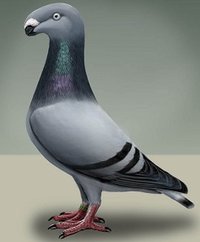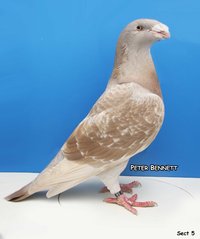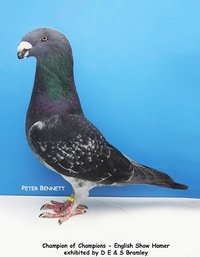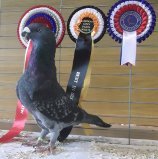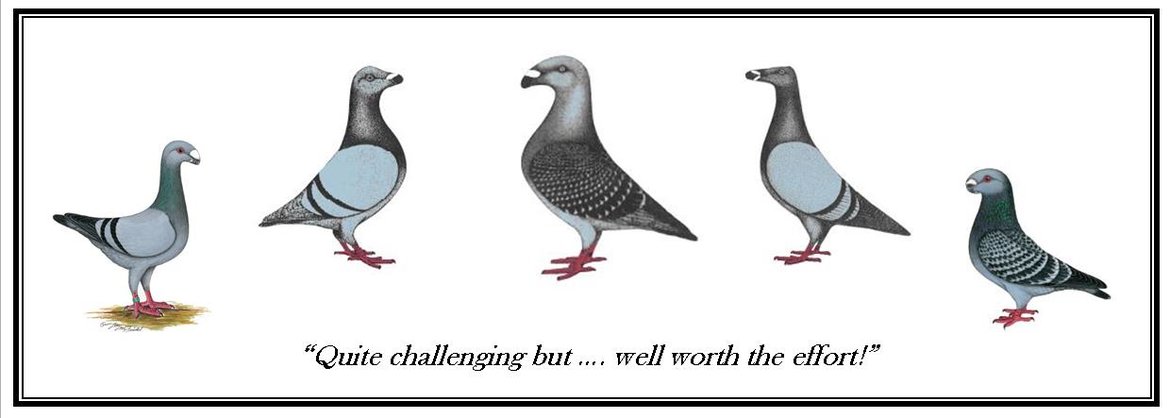Show Homer EE Standard
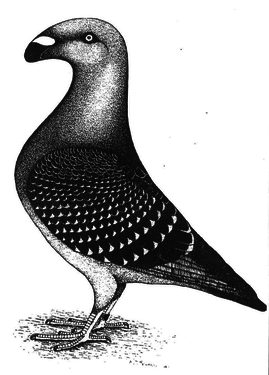
The United Fancy Homer Club (UK).
SHOW HOMER (EE Standard)
Origin: England, late 19th Century. A combination of the attributes derived from the Scandaroon, Antwerp, Tumbler and English Owl. First developed as a dual-purpose pigeon, namely for its “homing” quality and for use in the Show Pen. First breed club formed in 1886
Overall Impression: Rather a large bird, with a solid, wedge shaped body. The structure of the head is a splendid manifestation of the art developing a pigeon breed. The distance between the eye and the base of the beak is extremely long. In profile, the curve of the upper head should continue in an unbroken symmetrical arc to the back of the skull with no depression or break behind the wattle. A bird of curves.
Characteristics of Breed:
Head: The head is the most important feature, and requires each part to be separately detailed. Viewed from the side it should have a perfectly even and unbroken curve from the back of the skull to the tip of the beak. From the front or top, each side of the face should be well filled. The front and top skull also forming an unbroken curve from side to side. From the tip of beak to the centre of the eye, it should measure about 1 7/8” inches to 2”inches (47mm to 50mm)
Eyes: The eye should be white, bright and sparkling, giving the bird a wild appearance, as if always on the alert.
Eye Ceres: The cere should be damson black, very fine and hard texture, having the appearance of a silk cord encircling the eye. The softer colours having varying shades and a softer texture. Although there is a slight tendency to growth, the cere should remain naturally fine and dark.
Beak: The beak should be black, except in Silvers, Creams, Whites, Yellow or Dun Chequers. In these colours a tendency to lightness is permissible. Both mandibles should be of medium substance and so set that the perfect curve of the head is not interfered with. The upper edge of the under mandible should be quite straight, and both mandibles should fit closely together.
Wattles: The wattle should be white, naturally smooth, fine in texture and shaped in the form of a heart, with the division reaching at least half way down.
With age there is a tendency to growth, but it should be very slight, and for several years a fine, smooth appearance. No jewing should appear on the under mandible.
Throat: The throat should be clean cut, and perfectly free from thickness and gullet.
Neck: The neck should be short, thick at the base, but gradually tapering to the point where the head joins.
Body: The body should be short and strongly built, shoulders broad, chest well rounded, back broad, flat and straight. Keel of good depth, breastbone straight. The whole body from the shoulders to tail should have wedge shaped appearance.
Wings: The wings should be carried over the tail, flight feathers to short, strong and broad, well overlapping each other.
Tail: The tail should be short and narrow, closely drawn together, straight and well carried.
Legs: The legs should be short, strong and well set. The legs and toes should be quite free from feather.
Plumage: The feathers should be hard and close fitting and in great condition.
Stance/Carriage: The bird should be of bold upstanding appearance, showing a capability of great activity in all its movement.
Recognised Colours: In Chequers, the colours are blue, black, dun, red, yellow and silver. The chequering should be clear and distinctive throughout. The off colours consist of blues, silver, mealies and creams. These should have two broad and well-defined bars on the wings; there are also grizzles. Blacks, browns, duns and white self’s. The colour in all should be sound throughout. Pieds are allowed in each recognised colour.
Serious Faults: Pinched appearance behind the wattle. Not enough back skull. Flat on the top of the skull. Not enough height above the eye. Lack of Power/ substance, both in the head and body. Thin, open or wry beak. Twisted beak. Coarse or ill shaped wattle. Soft pale cere. Red/lemon gravel or hard eye. Thick throat or gullet. Frill or open feathered neck, long swan neck. Long shaped body, curved back. Crooked breastbone. Feathered legs or toes. Heavy or wry tail. White or pied rump/hock and other mis-markings in colours apart from Pied colour varities. Long legs, webbed feet, crooked claws or toes.
Order of Importance: It is vital importance that the highest standard should be obtained in a typical show specimen. Quality depends largely on a general combination of the chief characteristics of the breed, as opposed to exaggeration of one point. Mere substance should not predominate, but given two exhibits of equal quality, the stronger and longer headed bird should win. Birds when exhibited should be in perfect natural condition. Benefical preparation of an exhibit should be encouraged.
Judging:
Scale of Points:
Formation of Head 20 points.
Beak 10 “
Wattle 10 “
Eye & Eye cere 10 “
Throat &Neck 8 “
Body 12 “
Plumage & Tail 12 “
Legs & Feet. 3”
Condition& carriage 3 “
Colour 10 “
TOTAL 100 POINTS
Ring Size 11mm (UK size E)
Year of publication Re-formatted to meet EE-Standard model on 28th December 2011, at the AGM of the United Fancy Homer Club.
Breed Grouping Wattle/Head.
"Quite Challenging ......... but well worth the effort!"
Contact Us
